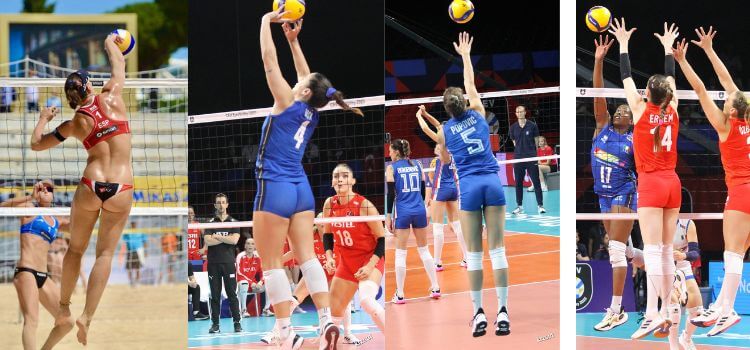As an Amazon Associate, I earn from qualifying purchases
Hi, volleyball enthusiasts! Are you looking to improve your vertical jump for volleyball? Whether you’re a seasoned player or a beginner, increasing your jump height can give you a competitive edge. This is very simple that everyone want actual and simple way to enjoy every game why not volleyball.
In this guide, we’ll explore the best techniques for increasing your vertical jump and help you achieve your athletic goals.
10 Best insoles for volleyball vertical jump
A higher vertical jump can be a game-changer in volleyball, allowing you to block shots and spike the ball with greater power and accuracy.
In this article, we’ll explore the techniques and exercises that can help you improve your vertical jump and reach new heights in your volleyball game.
Usefulness of the vertical jump in volleyball
Volleyball is a game of height, and a higher vertical jump can help you achieve that height. Your vertical jump is the measurement of how high you can jump off the ground from a standing position.
In volleyball, a higher vertical jump can help you reach the ball at the top of its trajectory, block shots, and spike the ball with greater force.
Simple foundation of vertical jump training
Before diving into specific exercises, it’s important to understand the basic principles of vertical jump training.
First, it’s important to incorporate a variety of exercises that target different muscle groups in your legs, hips, and core.

Second, you should focus on explosive movements that mimic the movements you make on the court. Finally, achieving tangible outcomes requires unwavering commitment and an unwavering resolve to maintain constancy. Aim to train your vertical jump at least three times per week.
movement to developed anyone vertical jumps
Improving your vertical jump can help you excel in a variety of sports, including basketball, volleyball, and track and field.
Whether you’re a seasoned athlete or just starting out, incorporating exercises that target your lower body can help you increase your jump height and improve your athletic performance.

In this article, we’ll explore some of the best exercises for improving your vertical jump.
1. squats
Squats are a classic lower body exercise that target your quads, hamstrings, and glutes. By strengthening these muscles, you can improve your power and explosiveness, which can help you jump higher.
To perform a squat, stand with your feet hip-width apart and lower yourself down as if you’re sitting back into a chair.
Maintain your weight centered on your heels and ensure that your knees do not extend beyond your toes. Revert back to the initial stance and replicate this process for multiple repetitions.
2. lunges
Like squats, lunges are a great exercise for targeting your lower body muscles. Lunges primarily work your quads, hamstrings, and glutes, but they also engage your calves and core muscles.
To perform a lunge, step forward with one foot and lower your body down until your front knee is at a 90-degree angle.
Make sure your back knee doesn’t touch the ground and keep your weight in your front heel. Resume your initial stance and proceed to repeat the movement using your alternate leg.
3. plyometric exercise
Plyometric exercises are explosive movements that can help improve your power and explosiveness. Some popular plyometric exercises for improving your vertical jump include:
3.1 box jumps
To perform a box jump, start by standing in front of a sturdy box or bench. Jump onto the box, landing with both feet and making sure to fully extend your hips at the top.
3.2 Depth Jumps
Depth jumps involve jumping off of a box or bench and immediately jumping back up as high as possible. This exercise can help improve your reactive strength and explosiveness.
3.3 Broad Jumps
Broad jumps involve jumping as far as possible with both feet. This exercise can help improve your power and explosiveness, as well as your overall jumping ability.
Calf Raises
Your calves are an important muscle group for jumping, as they help provide the push-off power you need to get off the ground.
To perform a calf raise, stand on a step or platform with your heels hanging off the edge. Raise your heels as high as possible, then lower them back down. Repeat for several reps.
application for improving anyone vertical jump
In addition to these exercises, there are several other factors to consider when trying to improve your vertical jump.
1 Dynamic Warm-Up
Before starting any workout, it’s important to warm up properly to prevent injury and prepare your muscles for exercise.
A dynamic warm-up, which involves moving your joints through a full range of motion, can help improve your flexibility and mobility, as well as prepare your muscles for explosive movements.
2 Proper Nutrition and Hydration
Proper nutrition and hydration are essential for athletic performance and recovery. Make sure you’re fueling your body with nutrient-rich foods and staying hydrated throughout the day to support your training efforts.
5.3 Rest and Recovery
Rest and recovery are just as important as exercise when it comes to improving your vertical jump. Make sure you’re getting enough sleep each night, and consider incorporating stretching, foam rolling, and other recovery techniques into your routine to help prevent injury and improve your overall performance.
4 Consistency and Progression
Enhancing your vertical leap requires a dedicated commitment and a persistent investment of time.
Make sure you’re incorporating these exercises into your training routine regularly and tracking your progress over time. Gradually increase the difficulty and intensity of your workouts as your strength and power improve.
Incorporating exercises that target your lower body muscles and explosive movements into your training routine can help you improve your vertical jump and overall athletic performance.
Remember to also prioritize proper nutrition, hydration, rest, and recovery, and to track your progress over time. With consistent effort and dedication, you can achieve your goals and improve your vertical jump. Related Post Best Volleyball jump box
making explosive energy
Improving your vertical jump is not just about building muscle strength; it’s also about building explosive power. Here are three techniques for building explosive power:
1 Proper Warm-up Techniques
Before any jump training, it’s important to properly warm up your muscles. Commence your workout routine by engaging in a brief session of gentle cardiovascular exercises, such as light jogging or performing sets of jumping jacks, for approximately five to ten minutes.
Follow this with dynamic stretches, such as leg swings and high knees.
2 Nutrition and Hydration
Proper nutrition and hydration are also important for building explosive power. Make sure to fuel your body with enough protein and carbohydrates to support your workouts, and drink plenty of water to stay hydrated.
3 Rest and Recovery
Rest and recovery are essential for building explosive power. Your muscles need time to recover and rebuild after a workout, so make sure to give them enough rest between workouts.
Aim to get at least 7-8 hours of sleep per night, and consider incorporating active recovery techniques, such as foam rolling or yoga, into your routine.
more idea for improve anyone vertical jump
Once you’ve mastered the basics, there are several advanced techniques that can help you improve your vertical jump even further. Here are three techniques to try:
1 Jump Rope Training
Jump rope training is a great way to improve your footwork and explosiveness. Incorporate jump rope exercises, such as single-leg jumps and double unders, into your routine to help improve your vertical jump.
2 Jumping Technique Drills
Improving your jumping technique can help you maximize your jump height. Try practicing jumping technique drills, such as standing broad jumps and depth jumps, to improve your form and explosiveness.
3 Mental Training
Finally, mental training can help you improve your vertical jump by helping you stay focused and confident on the court.
Visualization techniques, such as imagining yourself making a successful jump, can help you stay motivated and focused on your goals.
Conclusion
Improving your vertical jump can give you a competitive edge in volleyball and help you achieve your athletic goals.
By incorporating a variety of exercises that target different muscle groups, focusing on explosive movements, and staying consistent with your training, you can improve your vertical jump and take your game to the next level.
Frequently Asked Questions (FAQs)
How long does it take to see results from vertical jump training?
Results can vary depending on your starting point and how dedicated you are to your training. With consistent training, you can start to see results within a few weeks to a few months.
Can anyone improve their vertical jump, or is it genetic?
While genetics can play a role in your natural jump height, anyone can improve their vertical jump with consistent training and dedication.
Is it better to focus on plyometrics or weight training for improving my vertical jump?
Both plyometrics and weight training can be effective for improving your vertical jump. It’s important to incorporate a variety of exercises into your routine that target different muscle groups.
How often should I train my vertical jump?
Aim to train your vertical jump at least three times per week.
Are there any specific exercises I should avoid to prevent injury?
Some exercises, such as depth jumps or single-leg jumps, can be more advanced and should be approached with caution. Paying heed to your body’s signals and refraining from exercises that induce pain or discomfort is crucial for your well-being.